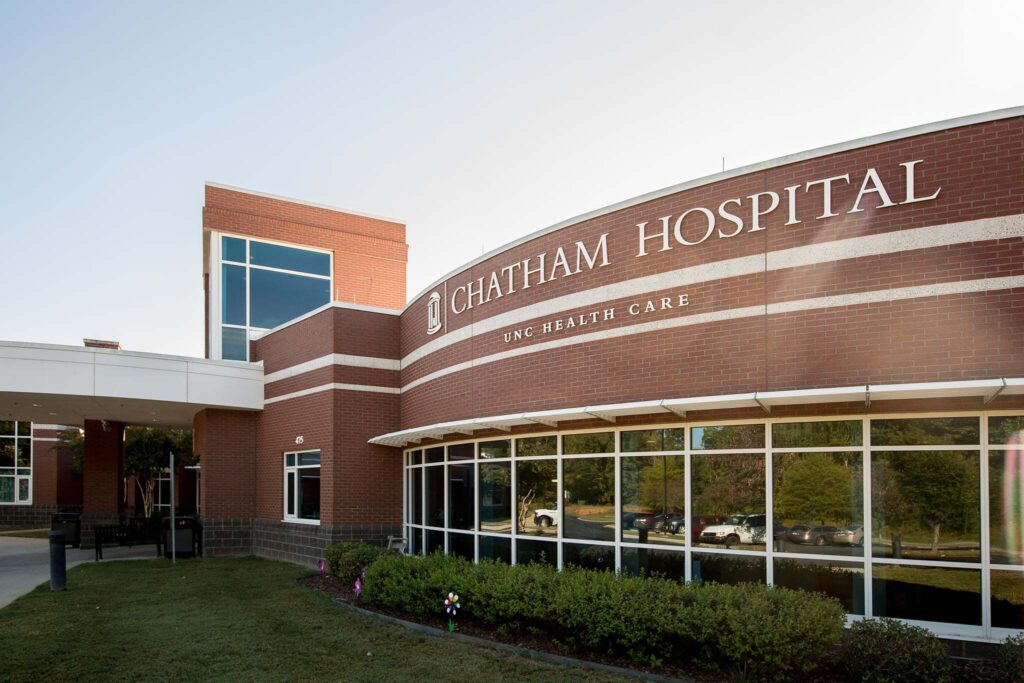Share this article
It’s just over 33 miles between Greensboro and Siler City. The two aren’t far apart, and in recent years, Siler City has become something of a suburb for Greensboro and the Research Triangle Park.
But despite their proximity, the two cities are quite different. Siler City has just over 8,000 residents; Greensboro has nearly 300,000. Chatham County has a rural, small-town feel, while Greensboro, as the third most-populous city in the state, is denser and more diverse.
The communities’ hospitals are equally different – Chatham Hospital is a 25-bed, critical access hospital, which means it provides essential services in a rural community. Cone Health, on the other hand, is one of the region’s largest, most comprehensive health systems. Its flagship hospital, The Moses H. Cone Memorial Hospital, has more than 600 beds alone.
But despite differences in size and scope, Chatham Hospital and Cone Health are equally committed to improving health equity in the communities they serve.
Health equity isn’t something most people spend time thinking about. The Robert Wood Johnson Foundation defines it as every person having a fair and just opportunity to be as healthy as possible, which “requires removing obstacles to health such as poverty, discrimination, and their consequences, including powerlessness and lack of access to good jobs with fair pay, quality education and housing, safe environments, and healthcare.”
Hospitals in the state play a critical role in ensuring every North Carolinian has a fair opportunity to be their healthiest. From addressing racial justice to supporting economic development, from improving the patient experience to acknowledging the impact of bias in healthcare settings, providers across the state are committed to reversing the effects of racism on our communities.
In particular, Cone Health and Chatham Hospital were both recognized by the American Hospital Association in 2020 for their specific commitments and efforts around equity. Cone Health received the association’s 2020 Carolyn Boone Lewis Equity of Care Award, and Chatham Hospital, part of UNC Health, was named an honoree.
For Cone Health, equity is an issue with historical significance. The hospital was a defendant in the 1963 lawsuit that ultimately led to hospital desegregation across the U.S.
“People tend to forget that there are people living who remember when they could not come to this hospital,” said Dr. Alvin Powell, a nephrology internist at Cone Health. “We have a significant and unique story to tell, a broader story about health disparities in America, which have to do with segregation and discrimination.”
But it isn’t enough to simply talk about providing accessible, equitable care for all, and the work undertaken by Chatham Hospital and Cone Health illustrates how hospitals in the state are making it a reality.
Everything starts with data

“Disparities have always been there,” said Laura Vail, director of Health Equity at Cone Health. “We’ve known about the disparities. But our data was not always this robust.”
We can’t fix what we don’t measure–so for hospitals at every size, the first step to improving health equity is collecting the right data.
In evaluating care outcomes, hospitals can determine whether disparities exist based on factors such as age, race, gender, gender identity, economic status, and other factors.
Both hospital systems shared that key to collecting better and more useful data was training staff to ensure patients are accurately represented.
“We had to train registration staff not to make assumptions about the race of a person, and that there is actionable work being designed off the information they collect, so they understand the importance of not making assumptions and letting patients self-identify,” said Vail.
When data shows that disparities do exist, it means certain groups are experiencing higher rates of illness or poorer outcomes, which gives physicians a roadmap for better helping these patients.
More equitable care

Physicians and other providers can take actionable steps to address inequities. One example is Cone Health’s postpartum hypertension program.
In looking at readmissions data, Cone found that Black women were being readmitted to the hospital for postpartum hypertension, or high blood pressure after giving birth, four times more often than white women.
Through direct interventions including unconscious bias training, new nursing techniques and new clinical protocols, the healthcare team was able to significantly reduce these disparities.
Birth equity is a focus for Chatham Hospital as well, which opened a new Maternity Care Center in September 2020, with a goal of improving health outcomes closer to home.
“In our first 15 deliveries, over half have been Latinx patients, which just shows how important this is to the experience we provide,” said Jeffrey Strickler, president of Chatham Hospital.
Other efforts at Chatham Hospital include an internship program for Spanish-speaking students to learn medical terminology and serve as medical interpreters, improving care for Spanish-speaking patients, and a long-term focus on building a pipeline of diverse candidates to improve diversity in leadership
Acknowledging unconscious bias

Addressing unconscious bias during healthcare experiences is a necessary step in improving disparities. Unconscious bias refers to the social stereotypes that we all form about other individuals, even outside of our conscious awareness. In a healthcare setting, unconscious bias can result in care decisions that lead to inequities.
Acknowledging and actively working against these biases is critical to ensuring all patients get the same care, no matter their race, age, financial situation or gender identity.
“When people come into the hospital, and we start labeling them before we get to know them and have that personal interaction with them and a relationship, that’s where the rubber meets the road,” said Keith Stinson, who leads Chatham Hospital’s equity efforts as well as serving as director of the Emergency Department. “That’s where we need to be going. Not taking them at face value or looking at them and making judgment calls.”
The impact of COVID-19, and where we go from here

The disproportionate and devastating impact that COVID-19 has had on communities of color has brought this issue front and center for hospitals in North Carolina. Multiple studies have clearly shown that Black Americans are contracting and dying from the virus at higher rates than white Americans.
“COVID-19 allowed us to recognize and spread the language about health equity around the organization, and other people started to speak the language. That was really powerful for us,” said Dr. Powell.
With the pandemic still surging across the state, both organizations plan to continue working closely with community groups to ensure patients and their families are able to get their healthcare and personal needs met.
“COVID will continue to be with us for months to come,” said Vail. “We’re looking for touchpoints with our community. We’ll continue to keep and strengthen those partnerships with groups that have a lot of faith in us to provide care beyond the four walls of the hospital.”
Building these collaborative community partnerships will improve health equity post-pandemic, too.
“In Chatham County, many of our patients don’t have access to transportation or healthy food, or safe housing. That’s such a big lift that any healthcare organization, especially a small rural facility, is just scratching the surface of work that needs to be done,” said Strickler. “Only through partnerships are we able to make that change.”
The North Carolina Healthcare Association and its 130-health system and hospital members are committed to creating equitable care for all North Carolinians.
To learn more about efforts undertaken across the state to create a healthier future for North Carolina’s people and communities, see our statement on Racism as a Public Health Crisis